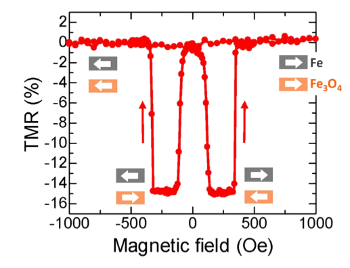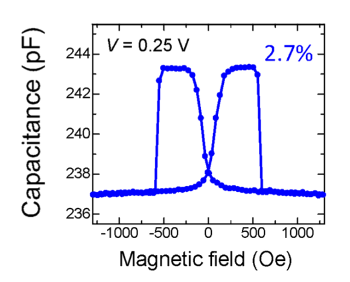Magnetocapacitive Tunnel Junctions
August 21, 2017
The transition from
vacuum tubes to
transistors as
computing components did not occur as quickly as you might expect. At the time of the
invention of the transistor, December, 1947, the vacuum tube was forty years old.
Lee de Forest (1873-1961), who earned a
physics Ph.D. under
J. Willard Gibbs at
Yale University, invented the
triode vacuum tube, which he called an
Audion, in 1906. At the time of the transistor's invention, the forty years of vacuum tube development produced
electronic switches that functioned at
ultra-high frequencies (UHF).
Vacuum tubes required considerable
power to produce the
thermionic electrons needed for their operation, they were also large, since their
volume needed to contain bits of
metal held at a particular spacing; and, as their name implies, all this was contained in a
vacuum envelope.
Computer engineers in the 1950s were eager to build
transistorized computers, but early transistors would barely operate above a few hundred
kilohertz, and only in a limited
temperature range. The first
consumer transistor device, the
Regency TR-1 transistor radio, introduced at the end of 1954, performed miserably, and it only needed to receive radio signals up to 1600 kHz.
Eventually, the
IBM 7090 was introduced in November, 1959. The 7090 contained more than 50,000
germanium bipolar junction transistors, and it was capable of computation at 100
Kflop/sec.
Current amplifiers, like
bipolar transistors, and
transconductance amplifiers, like vacuum tubes, are not the only electronic switches. The
tunnel diode, invented in August, 1957, by
Leo Esaki and
colleagues at what is presently
Sony, can be used as a
sub-nanosecond switch. Leo Esaki and
Brian Josephson were awarded the 1973
Nobel Prize in Physics for
research in the
quantum tunneling of electrons.
Tunnel diodes can be used as electronic switches because they exhibit
negative resistance; that is, a portion of their
current-voltage characteristic curve has the opposite
slope expected from a
resistor (see figure). Since they were also made from germanium, the workhorse
semiconductor material of the time, they were proposed as the high-speed replacement of transistors in computer circuitry. This, however, didn't happen, since transistors were easier to fabricate, and
silicon became the predominant semiconductor material.

A current-voltage (I-V) curve descriptive of a tunnel diode.
In the red region, the derivatives of I vs V, and V vs I are both negative, so the resistance is negative.
(Modified Wikimedia Commons image by "Chetvorno."
Magnetometers,
magnetic field sensors, are useful devices for a myriad of consumer applications, The most common of these are as a
wheel rotation rate sensor in
automobiles, and as an electronic
compass. Common magnetic sensing principles are
magnetoresistance, including
giant magnetoresistance (GMR),
Hall effect, and
fluxgate. Another magnetic effect, the
magnetocapacitance (MC) effect, is found in devices based on
multiferroic and
spintronic materials. As reported in a recent
open access article in the
journal,
Scientific Reports, a large magnetocapacitance effect is found in magnetic tunnel junctions formed as a sandwich of
Fe/
AlOx/
Fe3O4.[1-2]
A
research team comprised of
scientists from
Hokkaido University (Sapporo, Hokkaido, Japan),
Tohoku University (Sendai, Miyagi, Japan) and
Brown University (Providence, Rhode Island), followed-up on an earlier study demonstrating that changing the
electron spin orientation in a quantum magnetic tunneling junction can result in a large increase in the junction
capacitance.[3] In a normal magnetocapacitance effect, there's a higher capacitance when spins in the
electrodes on opposite sides of the tunnel layer are
parallel to each other, and a lower capacitance when spins are
antiparallel.[1]
This new research reports on the inverse of that, higher capacitance when the spins are antiparallel, an inverse tunnel magnetocapacitance (TMC) effect.[1] For a tunnel diode sandwich consisting of Fe/AlO
x/Fe
3O
4, the inverse TMC has a magnitude of up to 11.4% at
room temperature.[1] This is a novel spintronic device, a device whose operation depends not just on electron charge, but also electron spin.[2] The device structure, as shown below, has a tunnel layer of 2-4
nanometers of AlO
x.[1]

Structure of the tunneling magnetocapacitance device.
(Portion of fig. 1 of ref. 1, licensed under the Creative Commons Attribution 4.0 International License.)[1
In tunnel junctions made from electrodes of the highly magnetic material, iron-
cobalt-
boron, the research team demonstrated that a complete spin flip from anti-parallel to parallel could increase the junction capacitance by 150 percent. A
theory predicting this result also predicts that the capacitance change could be as high as 1,000 percent.[2]

Tunneling magnetoresistance (TMR) of the tunneling magnetocapacitance device.
(Portion of fig. 1 of ref. 1, licensed under the Creative Commons Attribution 4.0 International License.)[1
The
experimental data were found to agree with the
Debye-
Fröhlich model, modified by other models. Theoretical calculations predict that this inverse TMC effect could reach 150% in magnetic tunnel junctions having positive and negative
spin polarization of 65% and −42%. Such a strong effect would allow magnetic
logic circuits and multi-valued
memory devices.[1]
The iron oxide and iron layers have different
cation orientations in their
crystal structures, and this causes them to have inverse electrical properties.[2] Says
Gang Xiao, a paper
coauthor from the
Brown University physics department,
"We used iron for one electrode and iron oxide for the other... The electrical properties of the two are mirror images of each other, which is why we observed this inverse magnetocapacitance effect... Now we see that the theories fit well with the experiment, so we can be confident in using our theoretical models to maximize these effects, either the 'normal' effect or the inverse effect that we have demonstrated here."[2]

Capacitance change in a tunneling magnetocapacitance device.
(Portion of fig. 3 of ref. 1, licensed under the Creative Commons Attribution 4.0 International License.)[1
Aside from magnetic logic circuits and multi-valued memory devices, this effect could be used for magnetic sensors.[2] This research was funded by the
National Science Foundation and various
Japanese research agencies.[2]
References:
- Hideo Kaiju, Taro Nagahama, Shun Sasaki, Toshihiro Shimada, Osamu Kitakami, Takahiro Misawa, Masaya Fujioka, Junji Nishii, and Gang Xiao, "Inverse Tunnel Magnetocapacitance in Fe/Al-oxide/Fe3O4," Scientific Reports, vol. 7, Article no. 2682 (June 1, 2017), doi:10.1038/s41598-017-02361-4. This is an open access article with a PDF file available at the same URL.
- Researchers flip the script on magnetocapacitance, Brown University Press Release, June 1, 2017.
- Hideo Kaiju, Masashi Takei, Takahiro Misawa, Taro Nagahama, Junji Nishii, and Gang Xiao, "Large magnetocapacitance effect in magnetic tunnel junctions based on Debye-Fröhlich model," Appl. Phys. Lett., vol. 107, no. 13 (September 28, 2015), Article no. 132405, doi:10.1063/1.4932093.
Linked Keywords: Vacuum tube; transistor; computing; electronic component; invention; Lee de Forest (1873-1961); physics; Doctor of Philosophy; Ph.D.; J. Willard Gibbs; Yale University; triode; Audion; electronic switch; ultra-high frequency; electric power; thermionic emission; electron; volume; metal; vacuum; computer engineer; transistorized computer; kilohertz; temperature; consumer; Regency TR-1 transistor radio; IBM 7090; germanium; bipolar junction transistor; FLOPS; Kflop; electric current; amplifier; bipolar transistor; transconductance amplifier; tunnel diode; Leo Esaki; colleague; Sony; nanosecond; Brian Josephson; Nobel Prize in Physics; research; quantum tunneling; negative resistance; current-voltage characteristic curve; slope; resistor; semiconductor; material; silicon; derivative; Wikimedia Commons; magnetometer; magnetic field; sensor; wheel speed sensor; wheel rotation rate sensor; automobile; compass; magnetoresistance; giant magnetoresistance; Hall effect; fluxgate magnetometer; magnetocapacitance; multiferroic; spintronic; open access article; scientific journal; Scientific Reports; iron; Fe; aluminium oxide; AlOx; iron(II,III) oxide; Fe3O4; research; scientist; Hokkaido University (Sapporo, Hokkaido, Japan); Tohoku University (Sendai, Miyagi, Japan); Brown University (Providence, Rhode Island); electron magnetic moment; electron spin; capacitance; electrode; parallel; antiparallel; room temperature; nanometer; Creative Commons Attribution 4.0 International License; cobalt; boron; theory; quantum tunnelling; experiment; experimental; Peter Debye; Herbert Fröhlich; mathematical model; spin polarization; ;ogic gate; logic circuit; computer memory; cation; crystal structure; Gang Xiao; coauthor; Brown University physics department; parity; mirror image; National Science Foundation; Japan; Japanese.